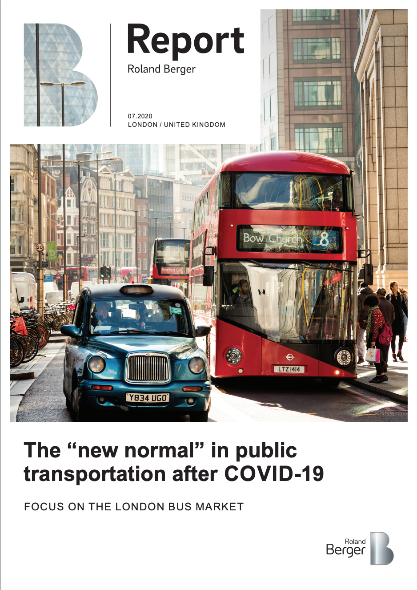The 'new normal' in public transportation after COVID-19
![{[downloads[language].preview]}](https://www.rolandberger.com/publications/publication_image/Roland_Berger_London_Bus_Market_Cover_download_preview.png)
The COVID-19 pandemic will trigger significant structural change in the London bus market.


By Kai Balder and Didier Bréchemier
Lockdown policies and strict hygiene measures brought about by COVID-19 pandemic have reduced the transportation services in some major cities by up to 90%. The London bus market, one of the most mature liberalized public transportation markets in Europe, has not come away unscathed. As such, it provides an ideal lens, through which to view the broader repercussions of COVID-19 on public transportation across the world. Roland Berger’s report, "The 'new normal' in public transportation after COVID-19" provides an overview of the London bus market prior to COVID-19 and assesses the short-term and long-term implications of the crisis.
"COVID-19 has magnified structural changes in public transportation, forcing operators to rethink their strategy."
The London bus network has been fully privatized since 1995 and currently consists of 700 routes across Greater London. While Transport for London (TfL) is responsible for networking, maintenance and contracting issues, ten private operators are active in the market today. The market had already been experiencing difficulties before the outbreak of COVID-19, with a decrease in ridership of 1.4% since 2014. This was largely due to increased congestion, increasing overall population wealth and the rising popularity of other transportation modes such as walking or cycling. To match decreasing demand, TfL had started reducing supply by lowering scheduled mileage, cutting routes or reducing Peak Vehicle Requirement (PVR). Despite this, prior to COVID-19 TfL forecasted an improvement to a flat trend of ridership by 2025.
Since lockdown and deconfinement phases began in March 2020, underground journeys in London have fallen by 95% and bus journeys by 85%. A survey conducted among 1,500 people in the UK during the early stage of lockdown revealed that 20% of bus commuters felt they would use public transport less after lockdown, largely due to fear of illness. As a result of people’s reluctance to use public transportation, TfL and London Mayor Sadiq Khan implemented a “Streetscape plan” to transform London’s streets and accommodate for a potential ten-fold increase in cycling and a five-fold increase in walking.
TfL’s deficit as a result of COVID-19 is estimated at 4 billion pounds. As a result of the fall in public transport passengers, TfL will likely cut lines and reduce PVR. Operators, who are already suffering from spare capacity, will find it increasingly challenging to optimize overhead costs without vacating entire depots. Furthermore, adhering to new hygiene requirements with middle-door boarding or extra signage will generate recurring investments for operators. A potential acceleration in the shift to electrification will also cause operators to incur additional costs.
In order to adapt to the deeper, structural changes facing public transportation, operators should consider it an opportunity to rethink their positioning. By elaborating portfolio strategies and investing in risk management, scenario planning and end-to-end, demand-related forecasting, operators can keep growing in a shrinking market and monitor the evolution of demand. Sustainable value creation, establishing a long-term electrification strategy and considering alternative value creation levers, such as consolidation or expansion outside their normal region will also be key measures for weathering the changes brought about by COVID-19. By launching several key initiatives pertaining to their strategic positioning and operational excellence, all stakeholders – transportation authorities, operators and passengers – can better adapt to the 'new normal'.
![{[downloads[language].preview]}](https://www.rolandberger.com/publications/publication_image/Roland_Berger_London_Bus_Market_Cover_download_preview.png)
The COVID-19 pandemic will trigger significant structural change in the London bus market.
